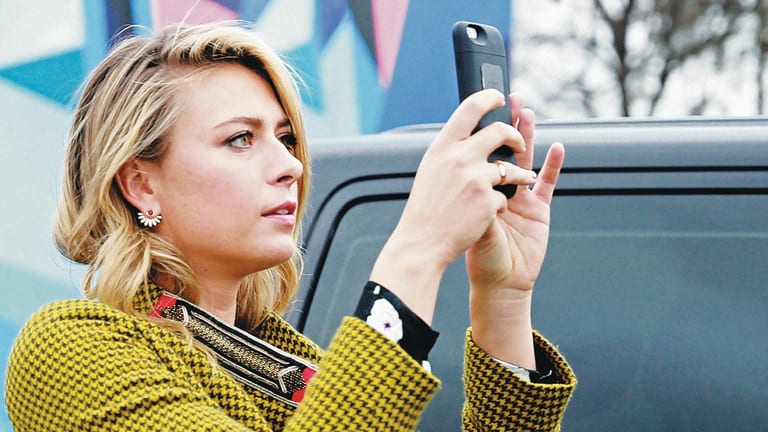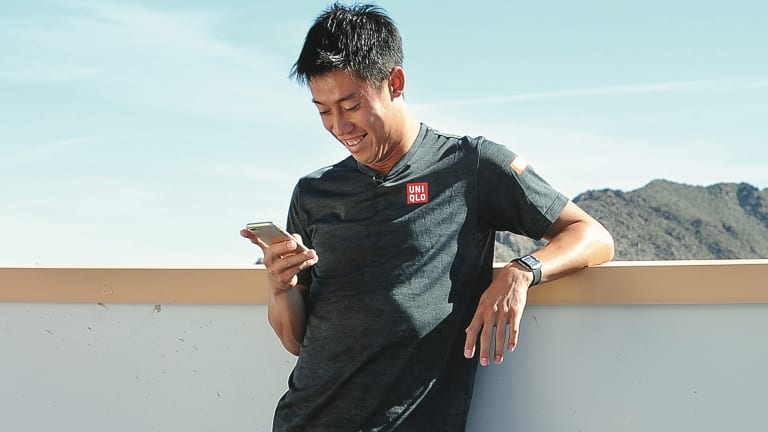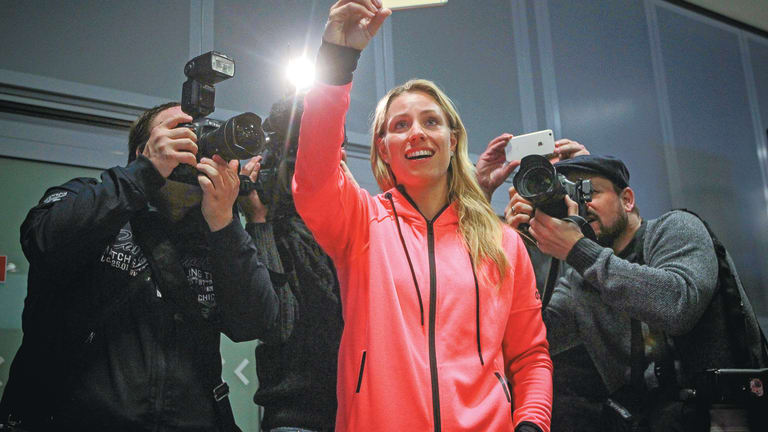Like Connection: How social media and tennis have gone viral
By Blair Henley Dec 11, 2019PHOTOS: Novak Yoga-vic? Djokovic preps for Indian Wells, connects with coach Andy Murray
By Ed McGrogan Mar 06, 2025Quote of the Day: Mirra Andreeva dreams of Andy Murray US Open mixed partnership
By David Kane Feb 19, 2025Novak Djokovic says no pain in hamstring after Matteo Berrettini loss in Doha
By Associated Press Feb 18, 2025Andy Murray to continue as Novak Djokovic's coach likely through French Open
By Associated Press Feb 18, 2025'Big Brother' is watching ... tennis: Many eyes, in many ways, are on the sport in 2025
By Peter Bodo Feb 13, 2025What's next for the Novak Djokovic and Andy Murray player-coach partnership?
By Baseline Staff Jan 24, 2025Novak Djokovic says his Australian Open win over Carlos Alcaraz was just as 'huge' for Andy Murray
By Baseline Staff Jan 21, 2025Can analytics help Andy Murray coach Novak Djokovic to Australian Open victory over Carlos Alcaraz?
By David Kane Jan 21, 2025Novak Djokovic and coach Andy Murray: A closer look at their early results Down Under
By Steve Tignor Jan 15, 2025Like Connection: How social media and tennis have gone viral
In 2010, Instagram became a part of our lives. Ten years later, social media's impact on tennis hasn't stopped going viral.
Published Dec 11, 2019
Advertising
When Cori “Coco” Gauff became the youngest player since 1991 to reach the fourth round at Wimbledon, she received congratulations via social media from megastars like Michelle Obama, Reese Witherspoon and Samuel L. Jackson. After her third-round comeback win over Polona Hercog, the 15-year-old used Instagram Live to express her shock, explaining that she forgot the score and thought she lost the match in the second set. She also wanted to tell her many new followers about yet another superstar shoutout.
“Jaden [Smith] posted me,” Gauff said with the dazed expression of a teenager who had just been personally addressed by her celebrity crush. “I had to go live to tell you that. He posted me on his Twitter and said I’m ‘The One’, and I cannot believe that.” Social media hasn’t always been second nature for professional athletes. In 2008, Serena Williams became one of the first notable tennis players to launch a Facebook page, more than a decade after turning pro. Maria Sharapova wasn’t far behind. Today the five-time major champion is neck-and-neck with Roger Federer and Rafael Nadal for the title of most followed tennis player on Facebook, with nearly 15 million page likes.

Like Connection: How social media and tennis have gone viral
© Copyright 2019 The Associated Press. All rights reserved.
Advertising
Getty Images:Gauff taking to Instagram following the biggest moment of her life is far less surprising than her breakthrough performance itself. Launched in 2010, the content-sharing site has existed since she was in kindergarten, and now boasts over one billion active users.
But while Facebook fan pages are akin to thumbing through a glossy magazine at a book store, Twitter, Instagram and Snapchat are high school hallways boisterous, personal and immediate. Those outlets have fostered a more authentic connection between players and the public over the past decade, removing the middleman and giving athletes direct control over their brands. Fans and media are along for the ride as athletes learn to navigate that newfound privilege on the fly. How much should they share? How do they best use it for good? Should they hire a social media manager? How do they handle criticism and negativity?
Social media uncertainty proliferates but from the very beginning, one thing has been as sure an Ivo Karlovic ace: a large digital following is an effective marketing tool for player sponsorships and side ventures. Williams announced the launch of a new Home Shopping Network clothing collection with her first tweet, in early 2009. Sharapova used her social network to help introduce her candy line, Sugarpova. Nadal’s social media created buzz for the 2016 opening of his eponymous academy in Mallorca. That same year, Novak Djokovic used Twitter to show off of his new vegan restaurant in Monte Carlo.
Beyond the marketing potential for off-court businesses, an athlete’s social media reach provides added visibility for sponsors. Thirty years ago, fans would have to watch a match on TV to get their first look at Steffi Graf’s new Adidas kit or Andre Agassi’s Head racquet. Today, those details are often disclosed in advance, with fancy photo shoots and brand-specific hashtags.

Like Connection: How social media and tennis have gone viral
© Sputnik via AP
Advertising
Getty Images
Kelly Wolf, a veteran tennis agent and vice president at Octagon, explains that while a strong social media following isn’t the only factor in endorsement negotiations, it’s in an athlete’s best interest to build their brand in the digital realm.
“Every endorsement agreement now includes a social media component,” says Wolf, “as advertising and marketing on Twitter, Facebook, Instagram, etc. are now the status quo.”
The premium placed on social media reach is something Mia Eklund knows all too well. Named Finland’s Female Tennis Player of the Year in 2017, she came close to breaking into the Top 500 the following season. The 25-year-old has sought out partnerships to help defray equipment and physiotherapy costs, and has repeatedly been told she needs a minimum of 10,000 followers to receive free goods or services.
“It doesn’t make me frustrated,” says Eklund, who has since started her own YouTube channel. “I just put more effort into social media, almost as a business or investment rather than just for fun.”
Beyond helping players pad their bank accounts, social media creates opportunities for altruism. Kevin Anderson has used Twitter and Instagram to build support for eliminating single-use plastic, including water bottles and bags covering players’ newly strung racquets. He saw the payoff at the 2018 Nitto ATP Finals, when the ATP tour initiated a reusable water bottle program. This year, Wimbledon became the first tournament to employ reusable racquet bags.
“Social media has proven to be a very powerful force in driving engagement and funding for our causes,” Anderson says. “It gives you your own platform to voice your concerns, and that has been enough to inspire change within our sport.”
Sloane Stephens has promoted everything from toothpaste to chocolate milk on her social feeds, but also uses them to raise awareness for the Sloane Stephens Foundation, which helps enhance quality of life for underserved youth through tennis and education. Stephens joins a host of players, including Djokovic, Monica Puig and Nick Kyrgios, who have used their accounts to help the less fortunate.
Noah Rubin has taken a different route. A former Wimbledon boys’ champion and top-ranked college player during his time at Wake Forest University, the Long Island native has used social media to shed light on the less glamorous side of the game.

Like Connection: How social media and tennis have gone viral
© 2014 Getty Images
Advertising
Getty Images: Andy Murray’s web-friendly wit has a massive audience: 3.6 million Twitter followers, and 1.7 million Instagram followers. He’s also let fans in on some of his more intimate moments. In 2016, Murray shared a photo of himself holding the Wimbledon trophy in an ice bath; earlier this year, after undergoing hip surgery, he posted a photo of himself in a hospital bed, along with the X-ray results.
The 23-year-old, who has spent most of his pro career ranked between 125th and 250th in the world, created an outlet to highlight the stories and struggles of those fighting for a spot in the game’s top echelon. Launched in January, the “Behind the Racquet” account sheds the filtered Instagram açade in favor of relatable stories of injury, struggle and hope. Eight months after Rubin’s first post, the account had over 25,000 followers.
Pam Shriver, who captured most of her 22 major doubles titles between 1980 and 1990, admits social media would have been helpful in promoting her various charitable pursuits, but doesn’t envy the players competing under its microscope.
“My worst behavior moments on the court over my 19-year career were plenty, and they did not get recorded and repeated over and over again. But, maybe seeing them might have prevented more from happening,” Shriver said with a laugh. “I can be a little impulsive still to this day. I imagine I would have sent some stupid tweets.”
The potential for reputational damage on social media isn’t always done in real time. Land mines deployed years ago could mean trauma later on. American Tennys Sandgren’s Twitter history overshadowed his breakthrough run to the 2018 Australian Open quarterfinals. Unearthed likes, retweets and exchanges with right-wing activists, along with a crass description of his experience at a gay club in 2012, created uproar on Twitter and beyond, quickly becoming international news.
“It’s something that’s very unique to this social media world to have thousands of people telling you how much they don’t like you in very expressive verbiage,” says the 28-year-old from Gallatin, TN. “There’s nothing that can really prepare you for it.”
Sandgren apologized for using language offensive to the LGBTQ community, and says he’s grown from the experience and conversations he’s had about it since. And for young players considering launching their own social media platforms, he has some advice.
“Be true to yourself,” he says. “On top of that, be somebody now that the ‘future you’ won’t regret.”
It’s not just players unfamiliar with the spotlight who have experienced social media growing pains. Williams accidentally announced her pregnancy on Snapchat in the spring of 2017. She quickly deleted an inadvertently posted photo of her baby bump captioned “20 weeks," but eagle-eyed fans forced her spokeswoman to officially confirm the news.

Like Connection: How social media and tennis have gone viral
© AP
Advertising
Getty Images: Kei Nishikori’s on-court success has led to a variety of off-court endorsements, including deals with Jaguar, Japan Airlines, Nissin and Procter & Gamble. Through his social media accounts, he’s able to give those companies even greater exposure.
In an effort to educate players on the potential and pitfalls of social media, both the ATP and WTA tours offer training for young players on the rise. Those who can afford it also have the option to hire a professional to manage their social media accounts. But even that has its risks. While some experts can nail the voice of their client, it’s often clear given the tone and composition of tweets or captions that a player is not creating original content. A loss of authenticity can mean a loss of followers.
Poor timing can also expose a proxy poster. After his loss to Federer at Wimbledon this year, Nadal’s Twitter account sent a congratulatory message while the Spaniard was still answering questions in his press conference. Three days earlier, Williams’ Instagram account released an image for a Harper’s Bazaar photo shoot during her three-set win over Alison Riske, prompting confused and sarcastic comments from fans.
Players aren’t the only ones working to fine-tune a social media strategy. Both tours and the majority of tournaments have entire departments dedicated to creating original content for social outlets.
Wimbledon has long been seen as a leader in digital sports content, racking up over 5 million followers on Facebook, 3.7 million on Twitter and 2.3 million on Instagram, with a constant stream of highlights, GIFs, graphics, animations and statistics. Lauded this year for its use of TikTok, a short-form video platform relaunched in 2018 by a Chinese company, Wimbledon seems to have mastered the real secret to social-media success: always look for what’s next. It’s a strategy that’s proven effective in a sport where growth relies on drawing in younger generations.
While social media’s gray areas are navigable, the dark side can be overwhelming. With professional tennis matches being played at some level every week of the year, it’s the fourth most bet on sport in the world behind soccer, cricket and basketball. Losing gamblers have used social media’s bridge of connectivity to abuse players, with everything from obscene insults to death threats.
Pittsburgh native Bjorn Fratangelo, a former Roland Garros boys’ champion who reached a career-high rank of No. 99 in 2016, highlighted the verbal abuse epidemic with a good-natured response to a compliment on Twitter: “Why thank you for the positive feedback! this [sic] is so different from the norm of people telling me they wish I would die of cancer.”

Like Connection: How social media and tennis have gone viral
© AP
Advertising
Getty Images: Anything you say can and will be used against you: it’s a warning for social media, too. When Angelique Kerber called Bianca Andreescu “the biggest drama queen ever” earlier this year, the clip spread like wildfire on Twitter. It also caught the eye of Kyrgios, who rarely turns down an online contretemps. The Aussie critiqued the German, who later tweeted congratulations to Andreescu.
Madison Keys has long been outspoken about the negativity and criticism she faces on Instagram.
And gamblers aren’t the only culprits. Trolls, as they are known in the digital world, have used the anonymity of social media to criticize everything from Keys’ tennis to her appearance. Fed up with the abuse, she decided to do something about it.
Through her partnership with youth organization FearlesslyGiRL, Keys helped launch the first annual Kinder Girl World Day on May 21, encouraging people to replace toxic online behavior with kindness. With boosts from fellow players Serena, Victoria Azarenka and best friend Stephens, Twitter exploded with positivity and encouragement.
“It’s not very often you see so many positive messages on social media,” Keys says. “For next year, we’re looking to get more participants spreading kindness in an effort to make it an even more viral moment.”
The biggest winners of the social media revolution in tennis are, undoubtedly, the fans. There is always action in the digital world even after the trophies are awarded.
They can watch a Kyrgios hot shot (or meltdown) to their hearts’ content, or analyze a Federer backhand in slow motion over and over again. They can cry along with Andy Murray as he considers retirement and send best wishes to Juan Martin del Potro as he recovers from injury. They can “ooh” and “ahh” over cute clips of Serena’s daughter and watch tennis couple Gael Monfils and Elina Svitolina known as G.E.M.S. Life on Instagram goof around. They can get to know Naomi Osaka as she candidly shares the pressures and frustrations of life in the spotlight, and be the first to see Gauff’s live post-match celebrations.
With any luck, the best parts of the game will continue to be shared beyond the confines of the core tennis community, creating new fans along the way. In the meantime, let’s remind ourselves that social media is us: human nature at its best, worst and everything in between.

Like Connection: How social media and tennis have gone viral